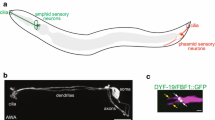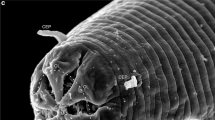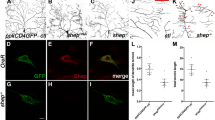Abstract
PTL-1, a microtubule-associated protein of the structural MAP2/tau family, is the sole member of this gene family in Caenorhabditis elegans. Sequence analysis of available invertebrate genomes revealed a number of single, putative tau-like genes with high similarity to ptl-1. The ptl-1 gene is expressed in a number of cells, most notably mechanosensory neurons. We examined the role of ptl-1 in C. elegans in adult neurons as well as during development. A ptl-1 knockout strain of worms exhibited an egg-hatching defect, as well as a reduced sensitivity to touch stimuli. In addition, the knockout allele ptl-1(ok621) acts as a dominant enhancer of several temperature-sensitive alleles of mec-7 and mec-12, which code the isoforms of β-tubulin and α-tubulin that together form the unusual 15 protofilament microtubules involved in touch sensation. These results demonstrate for the first time a functional role for this microtubule-associated protein in nematodes and suggest that PTL-1 is involved in mechanosensation as well as some aspect of embryogenesis.






Similar content being viewed by others
References
Altun ZF, Hall DH WormAtlas (2002–2006) http://www.wormatlas.org/ Cited 5 May 2008
Buddle M, Eberhardt E, Ciminello LH, Levin T, Wing R, DiPasquale K, Raley-Susman KM (2003) Microtubule-associated protein 2 (MAP2) associates with the NMDA receptor and is spatially redistributed within rat hippocampal neurons after oxygen–glucose deprivation. Brain Res 978:38–50
Chalfie M, Thomson JN (1982) Structural and functional diversity in the neuronal microtubules of Caenorhabditis elegans. J Cell Biol 93:15–23
Chalfie M, Sulston J, White JG, Southgate E, Thomson JN, Brenner S (1985) The neural circuit for touch sensitivity in C. elegans. J Neurosci 5:956–964
Chen J, Kanai Y, Cowan NJ, Hirokawa N (1992) Projection domains of MAP2 and tau determine spacings between microtubules in dendrites and axons. Nature 360:674–677
Cueva JG, Mulholland A, Goodman MB (2007) Nanoscale organization of the MEC-4/DEG/ENaC sensory mechanotransduction channel in Caenorhabditis elegans touch receptor neurons. J Neurosci 27:14089–14098
de Bono M, Maricq AV (2005) Neuronal substrates of complex behaviors in C. elegans. Ann Rev Neurosci 28:451–501
Dehmelt L, Halpain S (2004) Actin and microtubules in neurite initiation: are MAPs the missing link? J Neurobio 58:18–33
Doerflinger H, Benton R, Shulman JM, St.Johnson D (2003) The role of PAR-1 in regulating the polarized microtubule cytoskeleton in the Drosophila follicular epithelium. Dev 130:3967–3975
Duerr JS (2006) Immunohistochemistry In: WormBook (ed). The C. elegans Research Community, doi:10.1895/wormbook.1.105.1, http://www.wormbook.org
Ellgaard L, Riek R, Braun D, Herrmann T, Helenius A, Wuthrich K (2001) Three-dimensional structure topology of the calreticulin P-domain based on NMR assignment. FEBS Lett 488:69–73
Ernstrom GG, Chalfie M (2002) Genetics of sensory mechanotransduction. Ann Rev Genetics 36:411–453
Fukushige T, Siddiqui ZK, Chou M, Culotti JG, Gogonea CB, Siddiqui SS, Hamelin M (1999) MEC-12, an a-tubulin required for touch sensitivity in C. elegans. J Cell Sci 112:395–403
Goedert M (2005) Tau gene mutations and their effects. Movement Disorders 20:S45–S52
Goedert M, Baur CP, Ahringer J, Jakes R, Hasegawa M, Spillantini MG, Smith MJ, Hill F (1996) PTL-1, a microtubule-associated protein with tau-like repeats from the nematode Caenorhabditis elegans. J Cell Sci 109:2661–2672
Gu G, Caldwell GA, Chalfie M (1996) Genetic interactions affecting touch sensitivity in Caenorhabditis elegans. Proc Nat Acad Sci 93:6577–6582
Hahn M, Borisova S, Schrag JD, Tessier DC, Zapun A, Tom R, Kamen AA, Bergeron JJ, Thomas DY, Cygler M (1998) Identification and crystallization of a protease-resistant core of calnexin that retains biological activity. J Struct Biol 123:260–264
Harris TW, Chen N, Cunningham F, Tello-Ruiz M, Antoshechkin I, Bastiani C, Bieri T, Blasiar D, Bradnam K, Chan J, Chen C, Chen WJ, Davis P, Kenny E, Kishore R, Lawson D, Lee R, Muller H, Nakamura C, Ozersky P, Petcherski A, Rogers A, Sabo A, Schwarz EM, Van Auken K, Wang Q, Durbin R, Spieth J, Sternberg PW, Stein LD (2004) WormBase: a multi-species resource for nematode biology and genomics. Nucleic Acids Res 32:D411–D417
Hasegawa M, Smith MR, Goedert M (1998) Tau proteins with FTDP-17 mutations have a reduced ability to promote microtubule assembly. FEBS Lett 437:207–210
Heidary G, Fortini ME (2001) Identification and characterization of the Drosophila tau homolog. Mech Dev 108:171–178
Hunt-Newbury R, Viveiros R, Johnsen R, Mah A, Anastas D, Fang L, Halfnight E, Lee D, Lin J, Lorch A, McKay S, Okada HM (2007) High-throughput in vivo analysis of gene expression in Caenorhabditis elegans. PLOS Biol 5:1981–1997
McDermott JB, Aamodt S, Aamodt E (1996) ptl-1, a Caenorhabditis elegans gene whose products are homologous to the tau microtubule-associated proteins. Biochem 35:9415–9423
McKay SJ, Johnsen R, Khattra J, Asano J, Baillie DL, Chan S, Dube N, Fang L, Goszczynski B, Ha E, Halfnight E (2004) Gene expression profiling of cells, tissues, and developmental stages of the nematode C. elegans. Cold Spring Harbor Symp Quant Biol 68:159–169
Mukrasch MD, von Bergen M, Biernat J, Fishcher D, Griesinger C, Mandelkow E, Zweckstetter M (2007) The “Jaws” of the tau–microtubule interaction. J Biol Chem 282:12230–12239
O'Hagan R, Chalfie M, Goodman MB (2005) The MEC-4 DEG/ENaC channel of Caenorhabditis elegans touch receptor neurons transduces mechanical signals. Nat Neurosci 8:43–50
Permana S, Hisanage S, Nagatomo Y, Iida J, Hotani H, Itoh TJ (2005) Truncation of the projection domain of MAP4 (microtubule-associated protein) leads to attenuation of microtubule dynamic instability. Cell Struct Function 29:147–157
Riddle DL, Blumenthal T, Meyer BJ, Priess JR (1997) C. elegans II. Cold Spring Harbor Laboratory Press, Cold Spring Harbor, NY
Rolls MM, Satoh D, Clyne PJ, Henner AL, Uemura T, Doe CQ (2007) Polarity and intracellular compartmentalization of Drosophila neurons. Neural Dev 2:7
Saitou N, Nei M (1987) The neighbor-joining method: a new method for reconstructing phylogenetic trees. Mol Biol Evol 4:406–425
Sanchez C, Diaz-Nido J, Avila J (2000) Phosphorylation of microtubule-associated protein 2 (MAP2) and its relevance for the regulation of the neuronal cytoskeleton function. Prog Neurobio 61:133–168
Savage C, Hamelin M, Culotti JG, Coulson A, Albertson DG, Chalfie M (1989) mec-7 is a β-tubulin gene required for the production of 15-protofilament microtubules in Caenorhabditis elegans. Genes Dev 3:870–881
Savage C, Xue Y, Mitani S, Hall D, Zakhay R, Chalfie M (1994) Mutations in the Caenorhabditis elegans β-tubulin gene mec-7: effects on microtubule assembly and stability and on tubulin autoregulation. J Cell Sci 107:2165–2175
Siddiqui SS, Aamodt E, Rastinejad F, Culotti JG (1989) Anti-tubulin antibodies that bind to specific neurons in Caenorhabditis elegans. J Neurosci 9:2963–2972
Thierry-Mieg D, Thierry-Mieg J (2006) AceView: a comprehensive cDNA-supported gene and transcripts annotation. Genome Bio 7:S12
von Bergen M, Barghorn S, Li L, Marx A, Biernat J, Mandelkow EM, Mandelkow E (2001) Mutations of tau protein in fronto-temporal dementia promote aggregation of paired helical filaments by enhancing local β-structure. J Biol Chem 276:48165–48174
Acknowledgments
This work was supported by internal grant awards from the Dean of the Faculty Research Fund, the Abbey Fund and an NIH-AREA award 1R15NS057808-01(to K.M.R.-S.).
We would like to thank Cristian Opazo, Richard Wing, Amory Meltzer, Tasnim Rahman and Charlene Scotland for helpful assistance and Jerry Calvin for assistance with the confocal microscope. We would also like to thank Martin Chalfie for helpful discussions. This paper is dedicated to the memory of Michele Buddle (1962–2004).
Author information
Authors and Affiliations
Corresponding author
Additional information
Communicated by C. Desplan
Rights and permissions
About this article
Cite this article
Gordon, P., Hingula, L., Krasny, M.L. et al. The invertebrate microtubule-associated protein PTL-1 functions in mechanosensation and development in Caenorhabditis elegans . Dev Genes Evol 218, 541–551 (2008). https://doi.org/10.1007/s00427-008-0250-z
Received:
Accepted:
Published:
Issue Date:
DOI: https://doi.org/10.1007/s00427-008-0250-z




